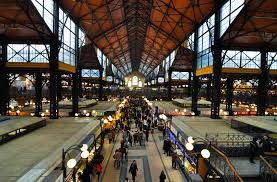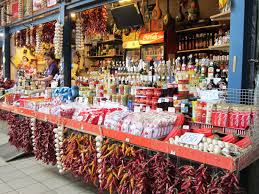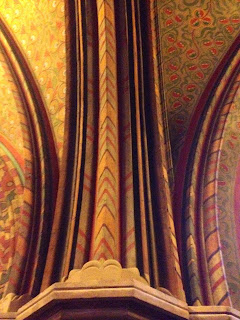 |
| Central Market, Budapest |
 |
| Paprika for Tourists |
Early to rise and to pack in as much Budapest as time would allow. First stop, the Central Market, just as it opened at 6:00 am. Time changes do wonders for sightseeing. Since I am writing a piece on the national ingredient of Hungary, Paprika, I headed to this gigantic indoor market. Comparisons to the length of football fields are not my forte but it’s safe to say this 100,000 square foot space is as large as one. It has three levels of shops and stalls. Completely destroyed at the end of the Second World War, it was only restored in the 1990s. It has since
 |
| Displays of Paprika are everywhere in the Central Market and on the streets. |
become one of the leading tourist attractions in all of Hungary. What this means is that among the sausage stands and pickle emporiums, there is every possible tacky souvenir imaginable, a great many of them clearly marked “Made in China”. Still, that doesn’t diminish the Market’s appeal as a purveyor of incredible foods in a spectacular setting. Light streams through windows high in the building illuminating fruit and vegetable stands, fresh herbs, hand produced jars of honey, ham, egg noodles and homemade cheeses. My quest as I said was for that most Hungarian of all ingredients: Paprika. Sadly, I was shocked to see that most stands featured tourist-ready packs in little sacks with painted wooden spoons. However I was able to find two representative Paprikas, one sweet and one hot out of the eight varieties Hungary is famous for. It was then a mad dash back to the ship for a quick breakfast and an 8:00 am departure for our City Tour.
Pest is on the flat side of Budapest and it’s where the city’s commercial heart is. Buda is far more tranquil, far more hilly and, according to our guide, where the fancy people live. Every Viking River Cruise includes shoreside excursions in Mercedes Benz coaches with local guides. Ours, Pal, pronounced Paul, was a fount of pride and history.
| Parliament as seen from the Buda Hill side of the city |
What did strike me was the depth of anti-Russian feeling that accompanied Pal’s re-telling of history. Hungary has a long tradition of being occupied by foreign nationalities of every stripe. The Soviets were only the last in a long line. But they may have been the most brutal of all. The Hungarian Uprising of 1956 was something I was very aware of because Canada accepted any number of refugees fleeing the Communists. These included the parents of my favorite niece, Valerie. But the Communists stayed on and on and only pulled up stakes completely in 1989. It was astonishing to listen to the litany of horrors visited on Hungarians by the Russians. Pal blamed them for everything from dumping gasoline and polluting ground water to why the country never had a functioning car manufacturer of their own.
The true beauty of Budapest is in its historic buildings and certainly not in the Communist-style apartment blocks that are now monuments to blight and the long years the country of struggle under Soviet oppression. Instead, places like the magnificent St. Mattias Church, which stands on the hill next to the Royal Palace, are the true testimony to Hungary’s brilliance in art and design. As beautiful as its architecture is, its interior is even more remarkable. Stenciling covers virtually every surface, giving the majestic church character and color that distinguishes it from any other Cathedral I have ever seen. (Although my friends at Christ and St. Stephen’s in New York know how beautiful stencils can be in a sanctuary.) These stencils cover every inch of the walls and the ceilings and the columns. Scroll down to the end of this post to see examples of this genius.
While we toured, the longship Tor moved upriver taking four hours to do so. It sailed against the swift currents encountered on its way upstream. We rejoined the Tor in Visegrad, some 50 kilometers upriver. Every day, our menus feature local specialties along with standard fare clearly geared to the North American palate. Today it was, surprise!, Hungarian goulash. Pictured here is the maitre d’, Peter Pasco, doling out another regional specialty, Austrian apfelstrudel, prepared as part of cooking demonstration that was part of the ship’s on-board program that day. (The Reverend Al is in the background in the chartreuse shirt).
 |
| KC and the Blue Curacao |
 |
| Prince Charles, seated next to Anne (with an E) of St. Louis. |













